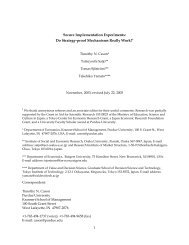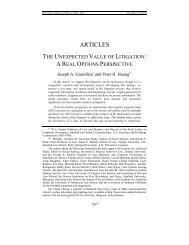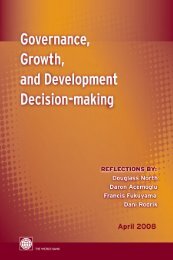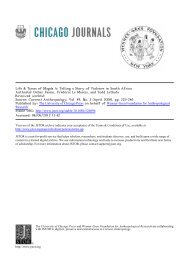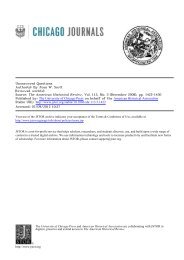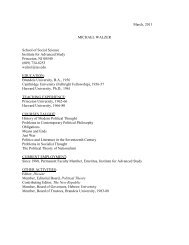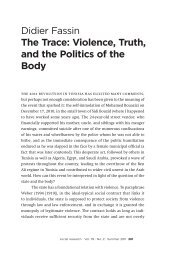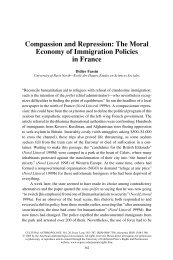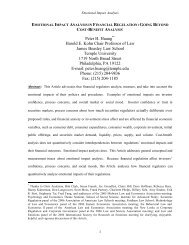The Tools of the Master Slavery and Empire in Nineteenth Century ...
The Tools of the Master Slavery and Empire in Nineteenth Century ...
The Tools of the Master Slavery and Empire in Nineteenth Century ...
You also want an ePaper? Increase the reach of your titles
YUMPU automatically turns print PDFs into web optimized ePapers that Google loves.
THE TOOLS OF THE MASTER 17<br />
32 Baer quotes one quite typical observation from British <strong>of</strong>ficials sent back to <strong>the</strong> Foreign<br />
Office: “[. . .]s<strong>in</strong>ce most <strong>of</strong> <strong>the</strong> slaves were an <strong>in</strong>tegral part <strong>of</strong> <strong>the</strong> families <strong>in</strong> which <strong>the</strong>y<br />
lived, <strong>the</strong>ir manumission <strong>in</strong>volved a breach <strong>in</strong> <strong>the</strong> secretiveness <strong>of</strong> <strong>the</strong> Arab family, so<br />
dear a value to <strong>the</strong> Egyptians [. . .]” [Borg to Cookson, Cairo, Oct. 21, 1877, F.O.<br />
141/112], <strong>in</strong> Baer, “<strong>Slavery</strong> <strong>and</strong> its Abolition”, p. 184. But similar quotes can be found<br />
<strong>in</strong> <strong>the</strong> treatise on slavery <strong>of</strong> Ahmed Chafik Bey, “De l’esclavage au po<strong>in</strong>t de vue musulmane”,<br />
Bullet<strong>in</strong> de la Société de Géographie de l’Egypte, vol. 5 (1892), p. 460.<br />
32 For <strong>in</strong>stance Al-Darra, 1874, <strong>in</strong> which Sanu’a dramatized <strong>the</strong> difficulties <strong>of</strong> multiple marriage<br />
for <strong>the</strong> first wife. Sanu’a was <strong>the</strong> best known, but certa<strong>in</strong>ly not <strong>the</strong> only playwright<br />
for whom this issue was important. O<strong>the</strong>r playwrights also focussed on <strong>the</strong> issue <strong>of</strong><br />
arranged marriages, re-evaluat<strong>in</strong>g <strong>the</strong> rights <strong>of</strong> fa<strong>the</strong>rs over daughters. Two <strong>of</strong> <strong>the</strong>se<br />
were Mahmud Wassif, ‘Aja’ib al-Aqdar, (Cairo: 1894) <strong>and</strong> Khalil Kamil, Dhalim al-’Aba’<br />
(Cairo, 1897).<br />
33 Beth Baron, “<strong>The</strong> Mak<strong>in</strong>g <strong>and</strong> Break<strong>in</strong>g <strong>of</strong> Marital Bonds <strong>in</strong> Modern Egypt” <strong>in</strong> Women<br />
<strong>in</strong> Middle Eastern History, Beth Baron <strong>and</strong> Nikki Keddie, eds. (New Haven <strong>and</strong> London:<br />
Yale University Press, 1991).<br />
34 BFASSP, Box G-29, Vivian to Allen, Cairo, 18 July 1881.<br />
35 Taj Hargay, “<strong>The</strong> Suppression <strong>of</strong> <strong>Slavery</strong> <strong>in</strong> <strong>the</strong> Sudan, 1898-1939,”p. 80.<br />
36 (Public Records Office) F.O. 84/1770, 19 April, 1886, from Lord Cromer to <strong>the</strong> Earl <strong>of</strong><br />
Rosebery, with enclosed extract from Schaefer to Cromer, April 18, 1886.<br />
37 Gabriel Warburg, Historical Discord on <strong>the</strong> Nile Valley (London: Hurst & Company,<br />
1993), pp. 15-16.<br />
38 Hargay, p. 455.<br />
39 Ibid, p. 80.



